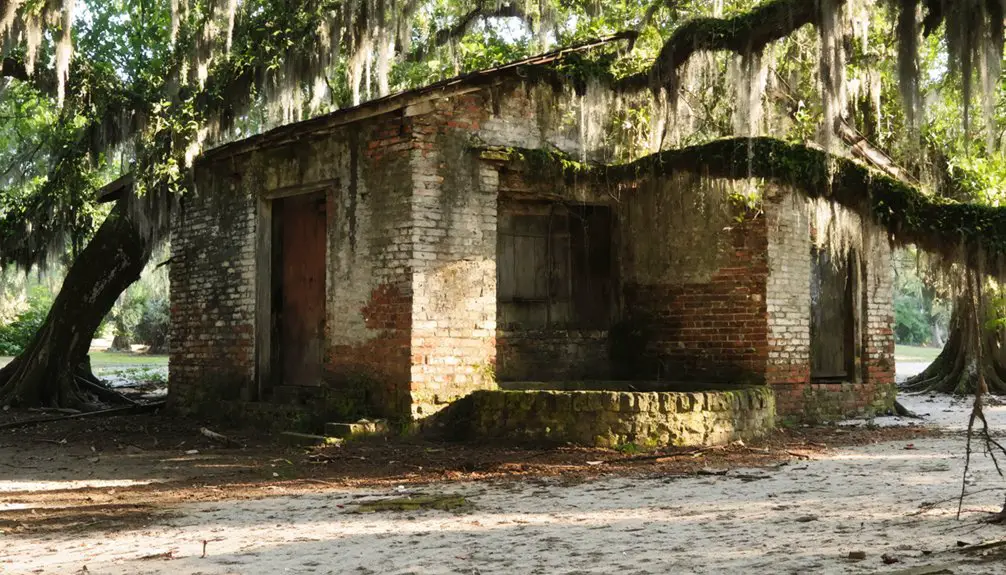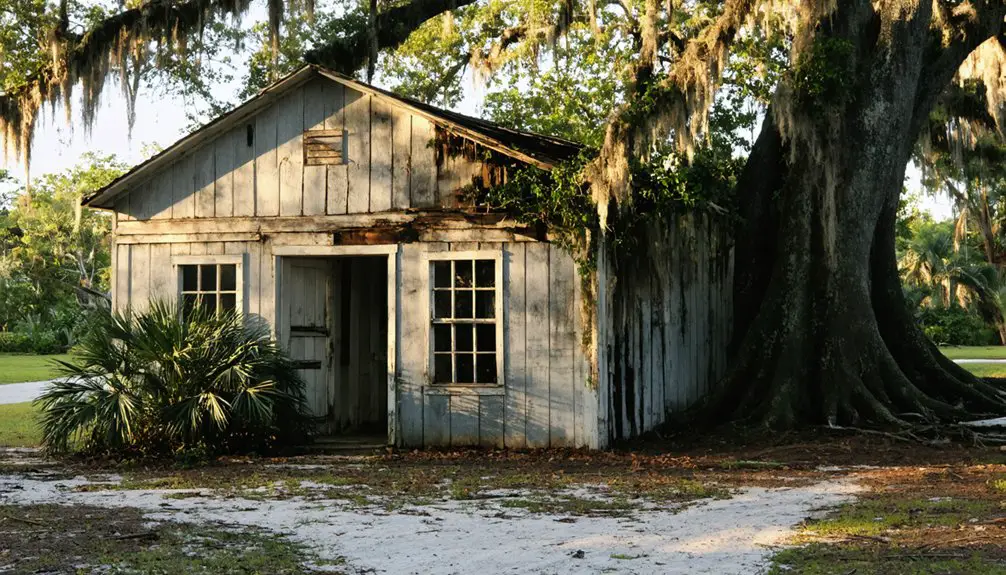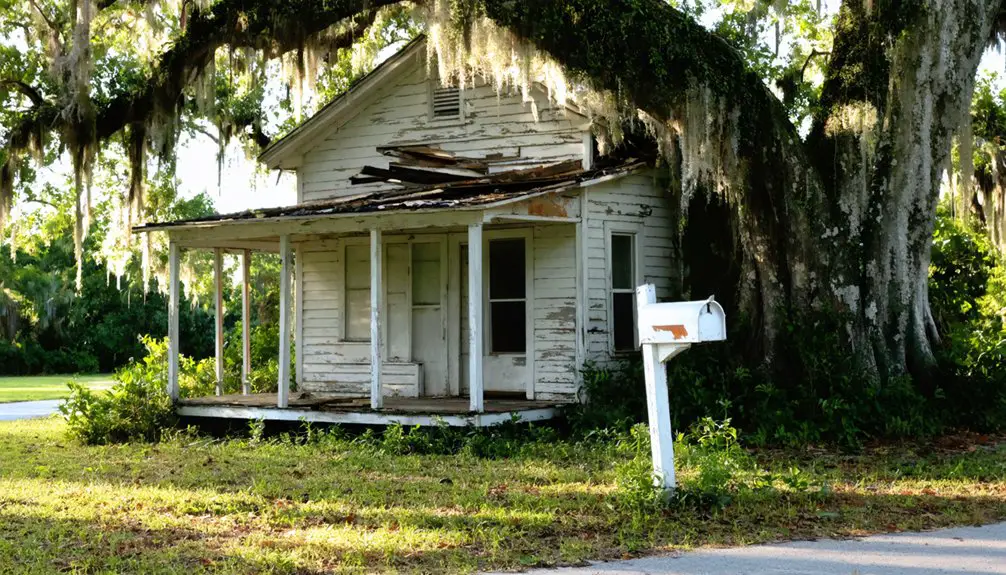You’ll find Torrey’s pioneering community established in 1904 amid Florida’s orange groves, where it flourished as both a citrus producer and sawmill town. The settlement grew rapidly through agricultural success and cypress logging, with families building lives around seasonal harvests and local trade. By the mid-20th century, devastating floods from raised dikes forced residents to abandon their homes. Archaeological digs in 2007 uncovered submerged artifacts, revealing deeper layers of this ghost town’s compelling story.
Key Takeaways
- Torrey was an agricultural community established around 1904, thriving on sawmill operations and cypress logging before becoming a ghost town.
- The town experienced significant population decline in the 1920s due to hurricanes and changes in flood control systems.
- Raised dike heights from 6 to 20 feet caused widespread flooding, forcing residents to abandon their homes by mid-20th century.
- Archaeological excavations in 2007 uncovered submerged artifacts confirming the complete abandonment of the settlement.
- Historical preservation relies on maps, postal records, and oral histories to maintain the cultural memory of Torrey’s community.
The Rise of Florida’s Citrus Pioneer
While Spanish explorers first introduced citrus to Florida in the early 1500s, likely through Ponce de Leon’s expeditions near St. Augustine, it wasn’t until the early 1800s that commercial citrus cultivation took root.
You’ll find the earliest attempts around 1818 on Merritt Island, where pioneering growers topworked wild seedlings into productive groves.
The British were the first to establish serious commercial operations, continuing their efforts even after Florida became a U.S. territory in 1821.
These early pioneer innovations faced brutal challenges – devastating freezes, persistent diseases, and limited transportation options often led to failure.
Despite these setbacks, determined growers persisted, learning from each failure and adapting their techniques.
Florida Indians played a significant role too, obtaining seeds from Spanish missionaries and helping establish early growing practices.
The development of railroad networks in the post-Civil War era revolutionized the citrus industry by enabling widespread distribution.
By 1860, Leesburg citrus hub emerged as the primary distribution center, enabling orange transport across the region.
Life Among the Orange Groves
The early Florida citrus growers didn’t just cultivate oranges – they built entire communities around their groves.
Florida’s early citrus pioneers wove their groves into the fabric of community life, creating settlements that flourished around the orange trees.
You’d find modest homes and cottages nestled within or near the groves, where families lived and worked together through the seasonal rhythms of grove life. During peak seasons, especially harvest time, you’d see everyone pitching in – from children gathering fallen fruit to hired crews managing the heavy lifting.
Grove traditions shaped daily existence, with community gatherings centered around harvest celebrations and shared labor. The area’s sandy soil conditions were perfect for growing citrus, making it possible for these communities to thrive. Orange processing plants became vital community anchors when operations like Hood Orange Juice opened in the 1940s.
While the rural setting meant relative isolation, the arrival of the Plant railroad system opened new opportunities. You could now ship your oranges to northern markets more efficiently, and the improved transportation brought seasonal tourists to the area, adding another income stream to the grove-centered economy.
Agricultural Heritage and Daily Activities
While farming communities around Torrey Island specialized in diverse crops beyond oranges, the daily agricultural operations required careful coordination of labor and timing for successful harvests.
You’d find workers meticulously tending to vegetables, fruits, and sugar cane across farms spanning up to 700 acres, with activities carefully scheduled around rail shipment timetables. Barn owls helped farmers maintain effective natural pest control on their lands, consuming thousands of crop-damaging rodents each year.
Early settlers relied heavily on local starch plants for sustenance, processing them carefully to remove toxins before consumption. Throughout the growing seasons, you’d observe farm laborers adapting their techniques to manage water levels, control pests, and prepare harvested produce for transport to northern markets via Flagler’s railroad.
Orange Grove Labor Practices
Deeply entrenched in racial segregation and exploitation, Torrey’s orange grove labor practices reflected the broader Jim Crow system that dominated Florida’s citrus industry through the early 20th century.
You’d find Black workers performing the most dangerous and physically demanding tasks, like picking fruit from thorny trees and pruning, while whites held privileged positions in the hierarchy.
Labor exploitation took many forms, from the “work or fight” laws of 1945 that forced Black workers onto chain gangs to the violent suppression of strikes by vigilante groups like the Ku Klux Klan.
When workers lived in company-owned shantytowns, they faced constant surveillance and poor conditions.
The shift away from cotton and tobacco led Florida to embrace citrus as commerce, creating new labor demands that perpetuated racial inequalities in the groves.
While later unionization efforts by the UFW attempted to unite workers across racial lines, the industry’s deep-rooted racial discrimination persisted through specialized labor roles and segregated facilities.
Under Mack Lyons’ leadership, the UFW established hiring halls to eliminate discriminatory crew leader practices and promote worker unity across racial divides.
Daily Farm Community Life
Life on Torrey Island’s farms began taking shape around 1904, marking a shift from the region’s exploitative labor practices to a more diverse agricultural community.
You’d find families practicing subsistence farming, growing everything from pineapples and pumpkins to beans and radishes for their own needs and local trade. The island’s farming history is now preserved through digital collections access for researchers and historians. These family-owned operations reflected the typical farm structure that would come to dominate Florida agriculture.
Your daily rhythm would’ve centered on crucial tasks: cultivating soil, managing water levels through canals, and carefully timing harvests.
Community cooperation proved essential, especially during major farming operations. You’d work alongside Bahamian neighbors who brought their own agricultural expertise to the mix.
When it came time to ship produce north, you’d face the challenge of complex transport routes, often waiting weeks to learn if your crops had survived the journey and secured payment.
Mapping Torrey’s Lost Landmarks
As you explore Torrey’s original boundaries, you’ll find traces of homesteads and agricultural infrastructure marked by remnant foundations and the distinctive water tower landmark.
Historical settlement patterns reveal a clustered community center near the church and municipal buildings, with farmlands radiating outward along established backroads.
The town’s footprint can be reconstructed through careful analysis of surviving structures, archaeological evidence, and archival maps that document the progression of development from early settlement through its eventual decline.
Tracing Original Town Boundaries
While tracing Torrey’s original boundaries presents significant challenges due to limited historical documentation, several key markers help reconstruct the ghost town’s footprint in modern-day Hardee County.
Using modern mapping techniques, you’ll find Torrey situated at approximately 27°36.6’N 81°49.5’W. Natural and manmade boundary markers, including aged trees and remnant street poles, provide essential reference points for understanding the town’s original layout.
- Historical photographs of Market Street showcase landmark features like wooden stop sign poles and red spigots
- Video documentation of remaining structures along the main thoroughfare helps establish rough boundary lines
- Physical artifacts and street remnants align with GPS coordinates to reconstruct the town’s historical footprint
These elements, combined with regional ghost town comparisons, offer insights into Torrey’s original municipal boundaries.
Lost Agricultural Infrastructure Locations
Three major categories of agricultural infrastructure once defined Torrey’s economic landscape: processing facilities, trade structures, and worker accommodations.
You’ll find remnants of sawmills that processed timber from cypress forests, while a local bakery and machine shops supported the agricultural community. General stores and trading posts, now reduced to foundations, served as essential hubs for farmers’ supplies and equipment.
The lost infrastructure included worker housing, communal dining halls, and support buildings that sustained the agricultural labor force.
Agricultural remnants also point to water management systems, with traces of irrigation networks that once served local farms. Near the waterways, you can spot evidence of former docks where boats transported farm products and timber to market.
Historical Settlement Pattern Analysis
Through careful mapping and archaeological studies, Torrey’s historical settlement patterns reveal a classic late 19th-century Florida town layout centered along a main street corridor.
The town’s design promoted strong community cohesion, with residential areas flanking the commercial district to the east and west. Public buildings, including the town hall and school, anchored the heart of the settlement, while the church’s prominent steeple served as a visual landmark throughout the community.
- The central business district formed Torrey’s spine, with homes radiating outward in a linear pattern.
- Religious and civic buildings occupied strategic locations to maximize accessibility and visibility.
- Peripheral zones contained informal gathering spaces and outbuildings, completing the town’s footprint.
Modern mapping efforts continue to uncover lost pathways and landmarks beneath years of abandonment, helping piece together Torrey’s original layout.
The Community’s Peak Years
During its heyday, Torrey flourished as a bustling sawmill town, experiencing dramatic population growth that mirrored nearby Hicoria’s surge from 125 to 587 residents by 1930.
You’d have found a massive sawmill operation larger than a football field, complete with concrete ramps and rail connections that kept the lumber flowing. The town’s economic dependence on cypress logging created hundreds of jobs overnight, drawing workers and their families to settle in the area.
While the community’s resilience showed in its development of essential services like a general store and boarding houses, you would’ve noticed the town’s vulnerability to flooding and restricted wage policies.
Workers and their families lived in modest homesteads, creating a close-knit but transient industrial community centered entirely around the mill’s success.
Environmental Factors and Town Development

While early settlers found Torrey’s coastal location promising for citrus cultivation, you’ll notice the high water table and salt-laden soils proved challenging for establishing productive groves.
You’d discover that the community initially relied on shallow wells for drinking water, though these often became contaminated by seepage from nearby wetlands.
Citrus Growing Conditions
The ideal citrus-growing conditions that initially attracted settlers to Torrey proved deceptively fragile due to the region’s location in Florida’s northern reaches.
You’d find the area’s well-drained, sandy soils initially supported healthy root systems for various citrus varieties, but the climate posed significant risks. The devastating Great Freeze of 1894-1895 exposed the vulnerability of northern groves, forcing growers to abandon their settlements and move southward where frost protection wasn’t as critical.
- Sandy soil with pH levels between 5.5-6.5 supported strong root development
- Periodic freezes and cold air drainage made consistent commercial success impossible
- Early technological advances in cold-resistant hybrids couldn’t overcome the region’s fundamental climate limitations
The environmental challenges ultimately proved too severe for Torrey’s citrus industry to overcome, despite innovations in growing techniques and frost protection methods.
Settlement Water Resources
Natural springs served as lifelines for Torrey’s early settlers, providing clean freshwater that had sustained indigenous populations for thousands of years before European arrival.
You’ll find these springs were essential for drinking, bathing, and maintaining local fish populations that residents relied upon.
Decline and Abandonment Timeline
Situated near Lake Okeechobee, Torrey’s decline began in the 19th century as a thriving fishing and agricultural community before facing a series of devastating setbacks.
The 1920s marked the beginning of major population migration, as hurricanes claimed nearly 1,000 lives and prompted significant changes to Lake Okeechobee’s flood control system. Economic shifts accelerated when the dikes were raised from 6 to 20 feet, causing widespread flooding that compromised the island’s habitability.
- By mid-20th century, recurring floods had forced most residents to abandon their homes and livelihoods.
- Transportation became limited to airboats and specialized vehicles during dry seasons.
- Archaeological digs in 2007 revealed only submerged artifacts and confirmed complete abandonment.
Today, Torrey stands as a ghost town, accessible primarily during drought conditions – a stark reminder of nature’s impact on human settlements.
Archaeological Discoveries and Remnants

Archaeological excavations near Torrey have yielded remarkable prehistoric discoveries, including well-preserved mastodon remains with evidence of human interaction.
You’ll find cut marks on mastodon tusks and bones alongside stone tool flakes, indicating prehistoric habitation by early human populations who hunted and scavenged these extinct megafauna.
Underwater archaeology at local sinkholes and springs has revealed stratified layers containing fossilized mastodon dung, aboriginal village remains, and artifacts from both Woodland and Archaic periods.
Ancient sinkholes near Torrey preserve a remarkable timeline, from mastodon remains to Native American settlements, frozen in underwater layers.
The archaeological significance of these sites is heightened by their excellent preservation in water-saturated environments.
Recent excavations, particularly after droughts, continue to uncover evidence of stone tool manufacturing and systematic butchering techniques, painting a vivid picture of early human settlement and their relationship with the region’s ancient ecosystem.
Preservation Efforts and Historical Records
While physical remnants of Torrey remain scarce, preservation efforts have focused on documenting the town’s history through archival initiatives and historical records.
You’ll find community engagement centered on collecting oral histories, family records, and photographs to preserve Torrey’s cultural memory. The archival challenges are significant, as there’s limited official historical designation and funding for preservation work.
- Historical maps and postal records help pinpoint Torrey’s location and operational timeline
- Local historical societies maintain collections of photos and artifacts for public display
- Publications and written histories capture personal stories and economic impacts that led to the town’s decline
Through these preservation methods, you’re able to piece together Torrey’s story despite the lack of surviving structures, ensuring this ghost town’s legacy endures for future generations.
Legacy in Hardee County’s History

Despite its physical disappearance, Torrey’s legacy endures as a significant chapter in Hardee County’s agricultural heritage.
You’ll find the town’s influence woven into community narratives that highlight its role in the late 1800s citrus boom, representing an era when orange groves defined the region’s economy and way of life.
The cultural impacts of Torrey continue to shape local identity through oral histories and historical records.
You can trace the town’s significance as a symbol of rural development and agricultural prosperity, followed by its decline that mirrors broader shifts in Florida’s interior regions.
Even without standing structures, Torrey’s story enriches your understanding of how single-crop economies and environmental factors influenced settlement patterns in Hardee County’s past.
Frequently Asked Questions
What Was the Exact Population of Torrey at Its Height?
You can’t determine Torrey’s exact peak population since no direct demographic records exist. Based on Torrey’s growth patterns and similar Florida ghost towns, it’s estimated to have been several hundred residents.
Were There Any Notable Crimes or Lawlessness in Torrey’s History?
You won’t find documented crime incidents specifically linked to Torrey’s history. While nearby ghost towns had basic law enforcement with small jails, Torrey’s records show no notable episodes of lawlessness.
Did Any Famous Personalities or Politicians Ever Visit Torrey?
You won’t find records of historical visits by famous personalities or politicians in Torrey’s past. Research shows no documentation of notable guests ever stopping in this small Florida settlement.
What Was the Average Price of Land in Torrey During Settlement?
You’ll find land value records from Torrey’s settlement remain unclear, though it likely followed similar settlement trends of the era – ranging from free homesteads to modest fees for federal land grants.
Did Torrey Have Its Own Newspaper or Local Media Outlet?
You won’t find evidence of local publications in Torrey’s media history. Residents likely relied on nearby regional newspapers and postal services for news, as smaller settlements rarely sustained their own outlets.
References
- https://www.youtube.com/watch?v=SfNW9rjRUbQ
- https://www.youtube.com/watch?v=-IUe3sTEHww
- https://www.youtube.com/watch?v=ov9YSsKtbDs
- https://en.wikipedia.org/wiki/Kreamer_Island
- https://www.ghosttowns.com/states/fl/torrey.html
- https://dos.fl.gov/historical/museums/historical-museums/united-connections/foodways/food-cultivation-and-economies/the-citrus-industry-in-florida/
- https://greenjeanfoundation.org/florida-citrus-from-spanish-origins-to-modern-challenges/
- https://stars.library.ucf.edu/cgi/viewcontent.cgi?article=7736&context=etd
- https://www.floridacitrus.org/about/our-history/
- https://floridaorange.com/blogs/news/the-history-and-evolution-of-floridas-citrus-industry



